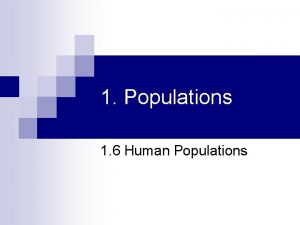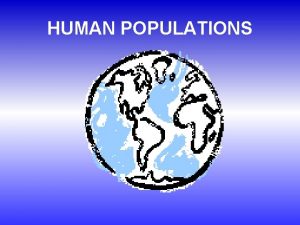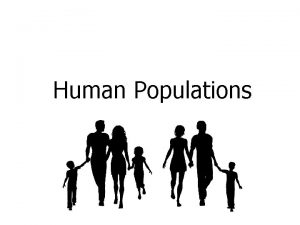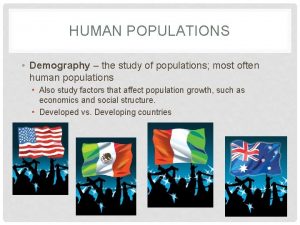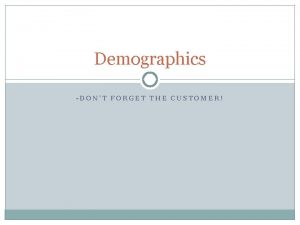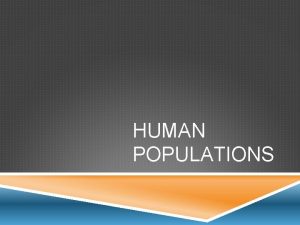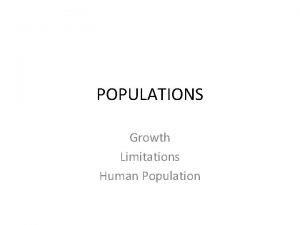Demographics Demographics the study of human populations What













- Slides: 13

Demographics

Demographics – the study of human populations • What factors could influence Average Age of a town? Provide two examples (old, young, middle aged? ) • How economic & cultural factors could cause a location to have a severe gender imbalance? • Why would a country have more young people than adults and how could this strain their economy? • What types of events could occur that could rapidly change a country’s: Death rate, migration rates, birth rates, or infant mortality? Examples?

What are some factors that influence human populations? • Migration Patterns – Economic recession & opportunities – Flee political/religious/individual oppression to freedom elsewhere • Cultural Influences – Religious values – family size, abortion vs. full term pregnancy – Gender bias/preferences • Economics & Income - Standards of living – Healthcare access – Sanitation & disease – Formal Education level – Planned Parenting Programs • Politics – War & conflict / Peace & stability – Government’s ability to satisfy people’s needs • Geography & Climate – Natural Resources Available: Food, Water etc. – Natural disasters: Drought, Floods, Tsunami etc

Population Pyramid – Age Picture Diagram A graph that shows the distribution of various ages groups in a population, which usually forms a pyramid Draw a population pyramid in your notebook and label all the parts Gender is split = Males on one side, Females on the other

USING THREE SEPARATE COLORED PENCILS – Accurately draw/record the graph below - Record Pop up Text Boxes after drawing the graph High CDR, High CBR, Low NIR Small total population Dropping CDR High CBR Increasing NIR Exploding population Low CDR Dropping CBR decreasing NIR Slowing population growth

Demographic Transition Model Record the Type of Economy into each of the Stages Stage 1 Pre-Industrial Econ. Stage 2 Hunter & Gatherer, Stage 3 Early Industrial Econ. Subsistence Developed Industrial Econ. Mining & Agriculture Stage 4 Manufacturing & Developed Economy Distribution Service Industry

Stage 1 Stage 2 Pre-Industrial Economy Hunting/Gathering, Subsistence Early Industrial Economy Mining and Agriculture Defining Characteristics High Birth Rate High Death Rate Small Total Pop Limited medical services/access Little-no formalized education Low standard of living Short life expectancy Little-no population growth Defining Characteristics High but Lowering Death Rate Improved medical care and sanitation High birth rate Some formalized education Moderate standards of living Rapid/High population growth Industrialization improves overall health and food supply USING THE PYRAMIDS BELOW Complete a Quick Sketch of each pyramid’s general shape below each stage Stage 3 Stage 4 Developed Industrial Economy Manufacturing and Distribution Developed Economy Services Defining Characteristics Continued drop in Death Rate Moderate standards of medical services Birth Rate begins to fall Most have access to formalized education Slowing population growth Moderate to high standards of living More intense economic development Awareness of less need for large families Increased opportunities for women (econ/edu) Population growth is minimal Low birth rate Low death rate Large(r) Total Pop Life expectancy is long Stable – declining population growth High levels of medical care and access High levels of formalized education & standards of living High costs of living, children are expensive to raise/educate ? ? Stage 5 - Declining Population ? ? USING THE CHART BELOW Accurately record the details of each stage below your graph

Stage 2 – Rapid Population Growth

Stage 3 – Rapid – Slowing Growth

Stage 4 – Slow/Stable/No Growth

Stage 5 - Declining Population

Venezuela’s Population through time Slowing Growth bottom angling slightly outward Stable - No Growth flat sides Stable – Slightly Declining flat sides - bottom angling inward

Teen Birth Control Access
 Hát kết hợp bộ gõ cơ thể
Hát kết hợp bộ gõ cơ thể Ng-html
Ng-html Bổ thể
Bổ thể Tỉ lệ cơ thể trẻ em
Tỉ lệ cơ thể trẻ em Chó sói
Chó sói Tư thế worm breton
Tư thế worm breton Chúa sống lại
Chúa sống lại Các môn thể thao bắt đầu bằng tiếng đua
Các môn thể thao bắt đầu bằng tiếng đua Thế nào là hệ số cao nhất
Thế nào là hệ số cao nhất Các châu lục và đại dương trên thế giới
Các châu lục và đại dương trên thế giới Công thức tiính động năng
Công thức tiính động năng Trời xanh đây là của chúng ta thể thơ
Trời xanh đây là của chúng ta thể thơ Mật thư anh em như thể tay chân
Mật thư anh em như thể tay chân 101012 bằng
101012 bằng















